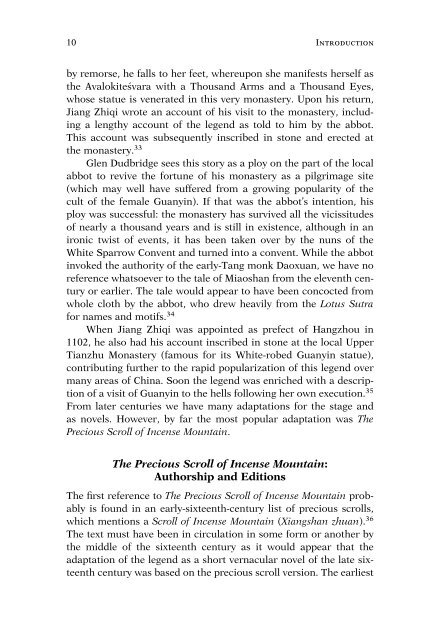Two Precious Scroll Narratives of Guanyin and Her ... - Khamkoo
Two Precious Scroll Narratives of Guanyin and Her ... - Khamkoo
Two Precious Scroll Narratives of Guanyin and Her ... - Khamkoo
Create successful ePaper yourself
Turn your PDF publications into a flip-book with our unique Google optimized e-Paper software.
10 Introduction<br />
by remorse, he falls to her feet, whereupon she manifests herself as<br />
the Avalokiteśvara with a Thous<strong>and</strong> Arms <strong>and</strong> a Thous<strong>and</strong> Eyes,<br />
whose statue is venerated in this very monastery. Upon his return,<br />
Jiang Zhiqi wrote an account <strong>of</strong> his visit to the monastery, including<br />
a lengthy account <strong>of</strong> the legend as told to him by the abbot.<br />
This account was subsequently inscribed in stone <strong>and</strong> erected at<br />
the monastery. 33<br />
Glen Dudbridge sees this story as a ploy on the part <strong>of</strong> the local<br />
abbot to revive the fortune <strong>of</strong> his monastery as a pilgrimage site<br />
(which may well have suffered from a growing popularity <strong>of</strong> the<br />
cult <strong>of</strong> the female <strong>Guanyin</strong>). If that was the abbot’s intention, his<br />
ploy was successful: the monastery has survived all the vicissitudes<br />
<strong>of</strong> nearly a thous<strong>and</strong> years <strong>and</strong> is still in existence, although in an<br />
ironic twist <strong>of</strong> events, it has been taken over by the nuns <strong>of</strong> the<br />
White Sparrow Convent <strong>and</strong> turned into a convent. While the abbot<br />
invoked the authority <strong>of</strong> the early-Tang monk Daoxuan, we have no<br />
reference whatsoever to the tale <strong>of</strong> Miaoshan from the eleventh century<br />
or earlier. The tale would appear to have been concocted from<br />
whole cloth by the abbot, who drew heavily from the Lotus Sutra<br />
for names <strong>and</strong> motifs. 34<br />
When Jiang Zhiqi was appointed as prefect <strong>of</strong> Hangzhou in<br />
1102, he also had his account inscribed in stone at the local Upper<br />
Tianzhu Monastery (famous for its White-robed <strong>Guanyin</strong> statue),<br />
contributing further to the rapid popularization <strong>of</strong> this legend over<br />
many areas <strong>of</strong> China. Soon the legend was enriched with a description<br />
<strong>of</strong> a visit <strong>of</strong> <strong>Guanyin</strong> to the hells following her own execution. 35<br />
From later centuries we have many adaptations for the stage <strong>and</strong><br />
as novels. However, by far the most popular adaptation was The<br />
<strong>Precious</strong> <strong>Scroll</strong> <strong>of</strong> Incense Mountain.<br />
The <strong>Precious</strong> <strong>Scroll</strong> <strong>of</strong> Incense Mountain:<br />
Authorship <strong>and</strong> Editions<br />
The first reference to The <strong>Precious</strong> <strong>Scroll</strong> <strong>of</strong> Incense Mountain probably<br />
is found in an early-sixteenth-century list <strong>of</strong> precious scrolls,<br />
which mentions a <strong>Scroll</strong> <strong>of</strong> Incense Mountain (Xiangshan zhuan). 36<br />
The text must have been in circulation in some form or another by<br />
the middle <strong>of</strong> the sixteenth century as it would appear that the<br />
adaptation <strong>of</strong> the legend as a short vernacular novel <strong>of</strong> the late sixteenth<br />
century was based on the precious scroll version. The earliest

















